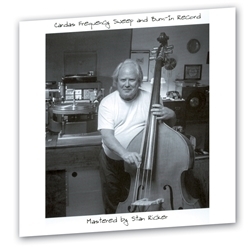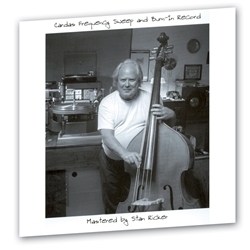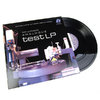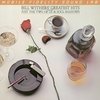Cardas - Half Speed Mastered by Stan Ricker - 180 Gram Virgin Vinyl
Unique tuning tool for system set-up, diagnostics and maintenance - Frequency Sweep LP More than just frequency sweeps, this famous LP contains multiple tracks to assist in turntable & system setup
Pressing: 180 gram Virgin , specially formulated hard vinyl
Mastering Lathe: Neuman VMS 66 lathe
Cutter Head: Helium cooled, Neuman SX-74
Controller: A Sontec Compudisk computer
Motor: Technics 5-speed direct drive Console and cutter head electronics: Keith O. Johnson
The Cardas Frequency Sweep and Burn-in Record is a unique tuning tool for system set-up, diagnostics and maintenance. It was produced by George Cardas and mastered by Stan Ricker. The ³Sweeper², in addition to the standard tones, includes relative and absolute polarity checks, vocal channel identification and frequency sweeps that ultrasonically clean the cartridge stylus and degauss the entire system. And, locked, pink noise grooves that repeat endlessly, blank plateaus, even a sync label to check platter speed. All on a 180 gram pressing with a smiling Stan cover.
Updated for 2010! Cardas Test LP is the burn-in and revitalization tracks. We guarantee that your analog front end will sound better after playing the demagnetization tracks, and the test tracks ensure everything is in optimum operating condition. This is an essential LP to own!
The Cardas Frequency Sweep and Burn-in Record is a unique tuning tool for system set-up, diagnostics and maintenance.Produced by George Cardas and mastered by Stan Ricker. The "Sweeper", in addition to the standard tones, includes relative and absolute polarity checks, vocal channel identification and frequency sweeps that ultrasonically clean the cartridge stylus and degausses the entire system. The Sweep LP also includes locked, pink noise grooves that repeat endlessly, blank plateaus, even a sync label to check platter speed. All on a 180 gram pressing with a smiling Stan cover.
Side 1 • Sweeper • 45 rpm (also works @ 33 1/3rd rpm).
Note: This is three cuts, interleaved with smooth sections, to be played at 45 rpm.
Track 1. Short Sweeps, short version (52 seconds)
Lock-out
Track 2. Short Sweeps, long version (4 minutes 46 seconds)
Lock-out
Track 3. “I’ve Got a Feeling I’m Falling” Artists: Tom Loncaric Band. Music Thomas Waller and Harry Link. Publisher: Ann Rachel Music. (2 minutes 29 seconds)
Lock-out
Track 4. 1K tone (740.46Hz tone @ 33 1/3rd rpm)
Lead-out spiral and final tie-off
Side 2 • Burn-In • 33 1/3 rpm. Note: Burn-in is mastered at two different speeds and designed to be played at 33 1/3 rpm. The first section, from the outside edge to the lock-out groove (the stylus will stay in the groove until lifted out), is mastered at 16 2/3 rpm. Tracks 2, 3 and 4 are mastered at 22 1/2 rpm.
Track 1a. Voice announcement by George Cardas, "Greetings from the left channel"
Spiral
Track 1b. Voice announcement by George Cardas, "From the right channel"
Spiral
Track 1c. Voice announcement by George Cardas, "From both channels" Note: This is lateral modulation (mono, in phase).
Spiral
Track 1d. "In polarity" Both channels in positive polarity
Spiral
Track 1e. "Out of polarity" Both channels in reversed or negative polarity Spiral
Track 1f. 13 strikes on a high "B-flat" on a piano Note: The last of the 3 strings are brought into zero-beat, dead-on tuning. Listen for the impact of hammer on string, quickly followed by room reflections mingling with one another, followed by a keener sense of the piano sound itself, as the ring-out time of the string exceeds that of the reverb time of the room.
Spiral
Track 1g. Hollow sticks, of various lengths and diameters, being struck, one on another. Note: It is recorded in a very reverberant, spacious environment. The spatial, impact and directional cues will not sound correct if the polarity is wrong.
Lock-out. Note: The remainder of this side is cut at 22.5 rpm and consists of three wide bands of pink noise, separated by two blank, 1/2 inch wide plateaus. The plateaus are protected by two blank grooves on each side, to keep the stylus from sliding into the pink noise. The three wide bands are groups of individually locked grooves of mono pink noise, recorded at "0" dB, relative to NAB standard level. These are continuous grooves and the stylus will stay in a groove until it is lifted out. This 180 gram pressing is made of specially formulated hard vinyl.
Track 2. 20 locked grooves, lateral modulation (mono)
1/2” wide, unmodulated plateau
Track 3. 32 locked grooves, vertical modulation (out-of phase)
1/2” wide, unmodulated plateau
Track 4. 20 locked grooves, lateral modulation (mono)
Track 5. 26 unmodulated grooves Note: These unmodulated grooves facilitate electro-forming (matrix) operations and help vinyl flow in the record press, for a quieter, flatter disk.
Lead-out spiral and final tie-off
Pressing: 180 gram, specially formulated hard vinyl
Mastering Lathe: Neuman VMS 66 lathe
Cutter Head: Helium cooled, Neuman SX-74
Controller: A Sontec Compudisk computer
Motor: Technics 5-speed direct drive Console and cutter head electronics: Keith O. Johnson
General Suggestions for Use
by George Cardas
The Cardas Frequency Sweep and Burn-In Record is a set of tools that audiophiles have requested over the years. The benefits and uses of the "Sweeper" vary because turn tables and systems differ, as does the knowledge and tools of the end user.
The most important tools on this record are the Side 1 Frequency Sweeps. These are the degaussing tracks 1 and 2. Simply play one of these tracks through your system at a low, normal level and it will degauss the cartridge and the rest of the system, plus clean the stylus ultrasonically. When played, the tracks progress from low frequencies at a high relative amplitude, to high frequencies (35 k+ if played at 45 rpm) at a low level. This is a complete degaussing process and an ultrasonic cleaning of the stylus at the same time. You may hear clicks and pops in the high frequency section after use. This is caused by the accumulation of junk which has fallen off the stylus during ultrasonic cleaning. Clean the record to remove the debris. This is the most efficient and cheapest way I know to degauss your cartridge and system. Basically, it makes a flux buster obsolete.
How often you use the Frequency sweeps is something you have to determine for yourself. The build up of residual stress in a system, is system dependent. Some parts require more frequent degaussing than others. For instance, permeable parts require more frequent degaussing than non permeable parts. An iron core cartridge will need more attention than ruby cored cartridge. Speakers with cored inductors acquire more stress than those with air core inductors. There should be an audible difference after you play the Frequency Sweeps. I run the sweeper at least once a week, it really works!
The sweeps are also useful as room tuning tools for setting up wall and ceiling treatments. Room reflection points, as well as other anomalies in the system, cause the image to shift with rising frequency. Simply sit in the hot spot and play the sweep at a low level. The image should be centered and stable in a well focused room. You can ignore changes in volume which are caused by comb filtering. Hard reflection points in the room can cause a shifting in focus, so padding these points will help stabilize the image. Hold a piece of foam rubber at arms length and block the sound from suspected reflecting points. When you think you have located the trouble spots, cover them with suitable damping materials.
An interesting speaker set-up trick is to listen to the low frequency, out of phase tones while sitting in the listening position. The note should cancel completely if speakers are positioned symmetrically. Try both tones and pick the one that works best for your room. Playing this tone while in the null point, at the hot spot, may also allow you to pick out strange noises and rattles in the system. Sorting out the exact cause of these anomalies is up to you.
The higher frequency tones must be measured in order to be compared. You can use these if you have setup machines and other ways of measuring. They are good for crosstalk type azimuth adjustments. Start by listening to or measuring the channel opposite the one being played and adjust it to minimum level. Then use any other test that needs relatively even tones of different frequency, but of the same level. Actual levels are approximate, but very even with respect to one another. If you have an oscilloscope, a triangle wave should have straight sides if all is right.
The voice announcements (Tracks 1a, 1b, 1c and 1d at the beginning of Side 2) are, again, for determining proper channels and centering the sound. They were recorded in a small booth and can be compared with the spatial qualities of Tracks 1f and 1g.
The continuous pink noise grooves at the end of Side 2 (Tracks 2, 3 and 4) are unique. They are concentric groves, not normal spirals. The stylus will stay in the grove until lifted out. I use these continuous grooves with discretion, to break in a new cartridge, but only after it is properly set-up. Part of this break-in process is the adjustment of the final azimuth. I can’t determine the length of break in time for your system, but I feel an hour would be close to the mark. Save your cartridge for music!
If all adjustments on the arm are correct and the table is perfectly level, the arm should track very slowly inward on the smooth sections of Side 2. This is an "after proper adjustment" test! It is not a way to adjust the tone arm.
If the system is out of relative phase, you will have to determine where one channel is reversed. It will often be one of the speaker connections or one of the cartridge connections. Usually the offending connection can be found by visual inspection. If the output of the out of phase, locked grooves (Side 2, Track 3) are combined, they should null. This can be used as an azimuth check.
The 1/2" wide, Unmodulated Plateaus on Side 2 are for checking cartridge alignment and tone arm bias. On level tables, properly adjusted arms will track slowly inward on the Plateau.
The Sync Label is used to determine the rotational speed of the platter. The label has four concentric rings of short, white lines to measure both 33.333 and 45 RPM. One set is for 60 cycle alternating current in the U.S. and the second set is for international, 50 cycle use. If you view the label under a standard incandescent or florescent lamp, the stroboscopic effect of the light will make the appropriate lines on the label appear to stand still when the speed is correct.

By day, Stan Ricker is the head buyer for the Telemetry Department at the Naval Air Warfare Center at China Lake. By night, he “is” Stan Ricker Mastering in Ridgecrest, California. Stan specializes in less-than-real-time disk mastering from analog tape, DAT, CD and CDR sources onto 7 or 12 inch, 33 1/3 or 45 rpm LPs. Though his mastering skills were self taught, Stan is known for his development of the half speed mastering process and his part in the creation of the 200g UHQR (Ultra High Quality Recording). A few of the LP labels Stan has mastered include: AcousTech Mastering, Analogue Productions, Stereophile, Windham Hill, Telarc, Delos, Reference Recordings, Mobile Fidelity Sound Lab, and Crystal Clear. All this skill and experience is brought into focus by Stan’s love of music. His earliest memories center around music. He began playing musical instruments very young. He obtained a Bachelor’s Degree in Music Education from Kansas University, he’s been a band leader and orchestra conductor, loves pipe organs and theories for tuning pipes, and to this day, bows and plucks the string bass and plays a mean tuba.
This frequency sweep and burn-in record is a unique tuning tool for system set-up, diagnostics and maintenance. It was produced by George Cardas and mastered by Stan Ricker. The “Sweeper” includes relative and absolute polarity checks, vocal channel identification and frequency sweeps that ultrasonically clean the cartridge stylus and degauss the entire system. Also, locked, white noise grooves that repeat endlessly, blank plateaus, even a sync label to check platter speed. This is a 180 gram pressing. Stan mastered it on a Neuman VMS 66 lathe with a Helium cooled, Neuman SX-74 cutter head. A Sontec Compudisk computer controller, and a Technics 5-speed direct drive motor were used. Keith O. Johnson designed the console and cutter head electronics.
A note on polarity:
The first burn-in section consists of voice announcements by George Cardas from the left, right and both channels. This is lateral modulation (mono, in phase). The tracks denoted "In polarity" feature George speaking into the front side of a Sennheiser MKH-20 condenser microphone which is figure-8 pattern only. The tracks denoted "Out of polarity", have George speaking into the back side of the same microphone. This microphone consists of a very thin (about 5 microns) Mylar diaphragm, suspended equidistant between two charged grids. This grid-diaphragm system is completely symmetrical, front-to-back, in terms of sensitivity, frequency response and polar response (the amount of high-frequency roll-off exhibited as the sound source moves increasingly off-axis to the plane of the diaphragm). The only difference between the signals derived from in-front-of vs. in-back-of the microphone is the absolute polarity. In microphones, electromechanically, positive polarity is defined as a positive pressure. For example, the "p" sound in polarity, causes the microphone diaphragm to move away from the sound source and rearward in the diaphragm-grid assembly. Further more, this rearward movement must produce a positive voltage at the designated (+) pin of the output connector. When George says "polarity" into the back side of the mic the diaphragm moves away from him. The diaphragm is moving towards the front of the capsule however, causing a negative (-) voltage to appear at the (+) pin , which is supposed to show positive (+) voltage. On a spoken voice, the effect of negative polarity is often subtle. On a singing voice, the effect becomes rather more evident. Wind instruments of the brass family (un-muted), produce a saw-tooth wave and the effect can be disastrous. It sounds worst on horn-loaded loudspeaker systems of high quality. Reverse polarity on a trumpet waveform means the loudspeaker diaphragm is moving rearward, away from the bell, or mouth of the horn and gives the effect of sucking on the trumpet mouthpiece, a near-impossibility. With bowed strings, from violin down to double-bass, especially when played solo, polarity makes it easy to discern the down-bows (positive polarity) from the up-bows (negative-going waveforms). If the polarity is reversed, the pairs of auditory cues become "cross-multiplied", causing an uncomfortable reaction in the listener, as the new pairs of cues simply do not exist in real life. By making the polarity correct, the pairs of cues line up, and everybody marvels at how "focused" the sound has suddenly become! Negative polarity with percussion instruments can cause snare drums to seem to lose their leading-edge transients and therefore, their clarity. Cymbals struck with sticks lose the instant of drumstick tip impinging on the brass of the cymbal. This causes the listener to try to boost the top end to a more forward sound. But alas, the next recording may have too much high end! Imagine a kick drum or a bass drum causing your woofers to recede or move away from you at the moment of impact!














